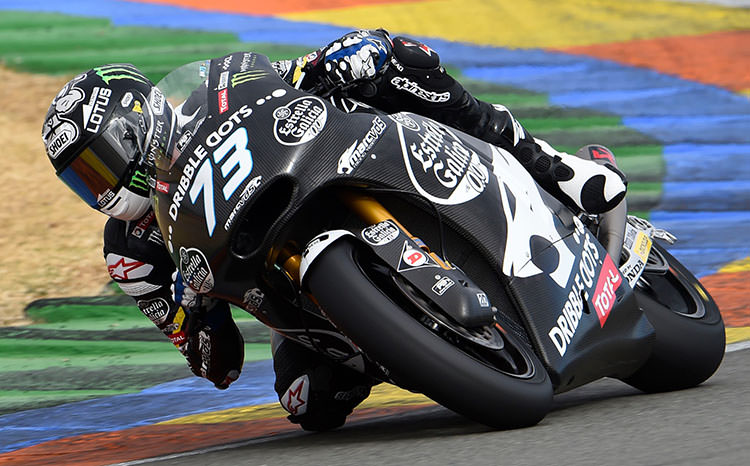Moto3 to Moto2: Making the transition
The natural progression for any successful Moto3 rider is to step up to Moto2, but success in the junior class aboard a lightweight, single-cylinder machine that produces only around 50BHP doesn’t guarantee immediate success when a rider climbs aboard a Moto2 bike, a bike with more then twice the power and with a lot more weight.
One rider making this transition in 2015 is reigning Moto3 World Champion, Alex Marquez, who tested the Team Estrella Galicia 0,0 Marc VDS Kalex Moto2 machine he’ll campaign in 2015 just days after wrapping up the World title in Valencia.
“Moto3 to Moto2 is a big change,” declared Marquez. “The Moto2 bike has more power, more than double that of the Moto3, but it also has a lot more weight. It’s not possible to ride the Moto2 like the Moto3; you need to change your riding style a little to get the best from it.
“For example, the braking points are completely different. In Moto3 you need to be really smooth on the brakes because the front tyre, and the contact patch, is small, but in Moto2 the transfer of weight means you can brake later and harder when the bike is upright. But the biggest difference comes when you turn in, as the additional weight starts to work against you and the bike wants to run wide. At the moment, the bike isn’t taking the line I want, it’s taking the line it wants, but we’re working to correct this so that I decide the line into the turn rather than the bike.”
It’s an observation Marquez’s Chief Mechanic, Naoya Kaneko, agrees with. “While the additional weight of the Moto2 bike generates more front grip under braking, this is only true when the bike is upright. As soon as you turn in then the tyre has to deal with the lateral force, which is much greater than in Moto3 due to the inertia of a Moto2 machine. To the rider it feels like the bike doesn’t want to turn in and, if they turn in harder, then the front will tuck. Finding the balance, so the bike follows the line dictated by the rider, is probably the single most important step in the transition from Moto3 to Moto2.”
“The exit is another story though,” continues Marquez. “The Moto2 bike wants to slide on the power whereas the Moto3 bike doesn’t really have enough power to unstick the rear tyre. I enjoy the sliding a lot, much more than the wheels in line style of Moto3.
“In the Valencia and Jerez tests I need to focus on corner entry. On exit we can see from the data that I’m already opening as early as Tito, but I still need to improve on the brakes. I need to find my braking points on the Moto2 bike and also build confidence with the bike, to allow me to brake later and harder. For me, this is what I need to focus on during the pre-season tests, because this is where we can find the biggest improvement ahead of the first race.
Where Marquez has a small advantage over many of the Moto3 riders who are stepping up to Moto2 alongside him is that his teammate, and fellow Team Rufea racer, is Tito Rabat, the reigning Moto2 World Champion. It also helps that his brother, double MotoGP World Champion Marc Marquez, made a similar transition from the 125cc class to Moto2 back in 2011.
“Marc had some advice after my first two tests on the Moto2 bike at the end of 2014. He suggested that I make a little bit more use of my elbow, to have another point of support in the turns, so I will try to take his advice and, step-by-step, work to close the gap on the more experienced Moto2 riders.”

